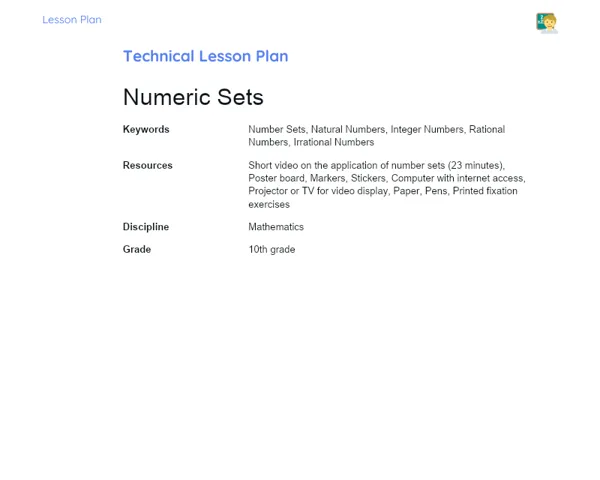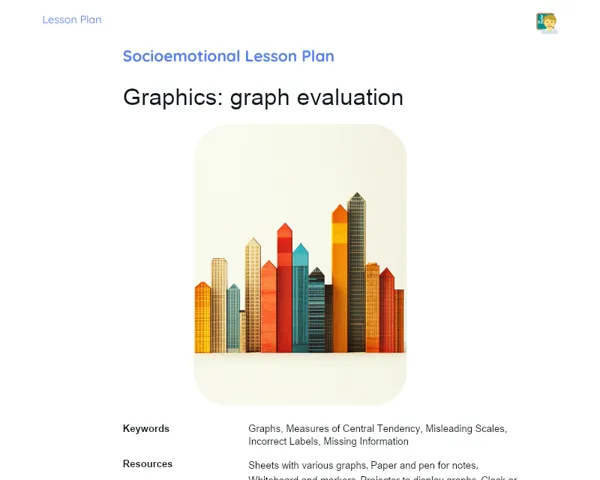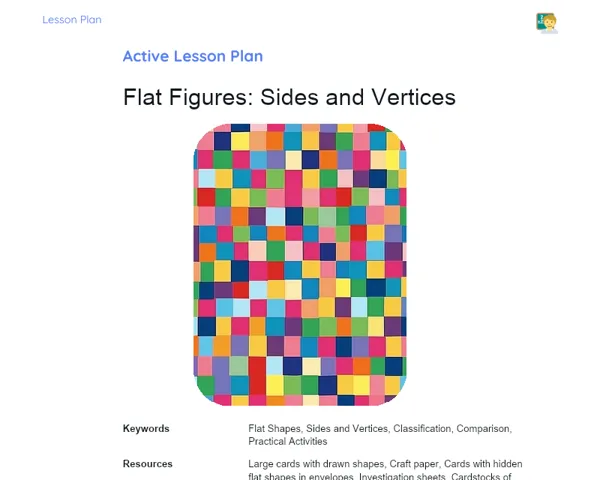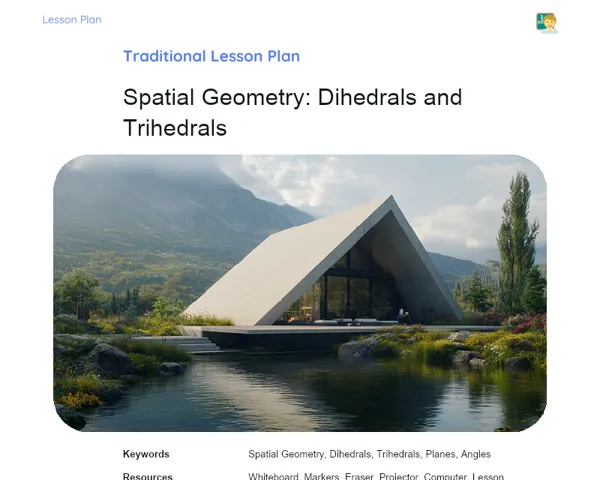Lesson Plan | Lesson Plan Tradisional | Triangles: Congruence
| Keywords | Triangles, Congruence, Side-Side-Side (SSS), Side-Angle-Side (SAS), Angle-Side-Angle (ASA), Angle-Angle-Side (AAS), Geometry, Problem Solving, Practical Applications, Engineering, Architecture |
| Resources | Whiteboard, Markers, Eraser, Ruler, Protractor, Compass, Projector or printed slides with visual examples, Sheets of paper, Pencils, Eraser |
Objectives
Duration: (10 - 15 minutes)
The aim of this lesson plan stage is to ensure that students grasp the fundamental concepts of triangle congruence, enabling them to enhance their understanding and apply these concepts in problem-solving. This solid foundation will allow them to keep pace with and actively engage in further explanations and activities.
Objectives Utama:
1. Understand that two congruent triangles have equal angles and sides.
2. Learn the main cases of triangle congruence (SSS, SAS, ASA, AAS) and apply them to solve problems.
Introduction
Duration: (10 - 15 minutes)
The goal of this lesson plan stage is to motivate learners by igniting their interest and curiosity around the subject. By sharing context and interesting facts, students can appreciate the relevance of studying congruent triangles, leading to greater engagement in the concepts that will be unpacked throughout the lesson.
Did you know?
Did you know that the ancient Egyptians employed congruent triangles in the construction of the pyramids? They used ropes with knots spaced evenly to create perfect angles, ensuring that all faces of the pyramids had consistent measurements, showcasing the practical application of triangle congruence in engineering and construction.
Contextualization
To kick off the lesson on triangle congruence, point out the significance of triangles in mathematics and our everyday lives. Discuss how triangles are the most basic geometric shape which can effectively segment more complex shapes, and highlight their extensive use in fields like architecture, civil engineering, and design. Emphasise that grasping triangles and their properties is key to tackling practical and theoretical problems across various subjects.
Concepts
Duration: (60 - 70 minutes)
This stage of the lesson plan aims to ensure that students gain a comprehensive understanding of the cases of triangle congruence and how to apply them in problem-solving. Through exploring each case with examples and geometric proofs, as well as solving guided problems, students will build a robust practical and theoretical understanding necessary to master the topic.
Relevant Topics
1. Definition of Congruent Triangles: Explain that two triangles are congruent when they have equal corresponding angles and sides. Use visual examples to illustrate congruence.
2. Cases of Triangle Congruence: Detail the four main cases of triangle congruence: Side-Side-Side (SSS), Side-Angle-Side (SAS), Angle-Side-Angle (ASA), and Angle-Angle-Side (AAS). Provide examples and geometric proofs for each case:
3. Side-Side-Side (SSS): All three sides of one triangle are equal to the three sides of another triangle.
4. Side-Angle-Side (SAS): Two sides and the angle between them of one triangle are equal to those of another triangle.
5. Angle-Side-Angle (ASA): Two angles followed by the side between them of one triangle are equal to those of another triangle.
6. Angle-Angle-Side (AAS): Two angles and a non-included side of one triangle are equal to those of another triangle.
7. Practical Applications: Discuss the real-world usage of triangle congruence, such as in civil construction, architecture, and engineering. Provide examples of situations where triangle congruence is vital.
8. Guided Problem Solving: Present classroom problems to solve, detailing step-by-step how to apply the congruence cases to arrive at solutions. Include a variety of problems that reflect different cases of congruence and encourage students to follow along.
To Reinforce Learning
1. 1. Two triangles have corresponding sides measuring 6 cm, 8 cm, and 10 cm. Are they congruent? Justify your answer.
2. 2. If two triangles share two equal angles and the side between those angles is also equal, what case of congruence does this represent? Solve a numerical example.
3. 3. Given a triangle with sides measuring 5 cm, 12 cm, and 13 cm, determine if it is congruent to another triangle with angles of 30°, 60°, and 90° and one side measuring 5 cm. Explain your reasoning.
Feedback
Duration: (15 - 20 minutes)
The goal of this lesson plan stage is to review and consolidate the students' understanding of triangle congruence concepts. Discussing the answers helps clarify doubts, validates reasoning, and reinforces learning through collective engagement and teacher feedback.
Diskusi Concepts
1. 1. Two triangles have corresponding sides measuring 6 cm, 8 cm, and 10 cm. Are they congruent? Justify your answer. Explanation: Yes, the triangles are congruent. By the SSS criterion (Side-Side-Side), we know if all three sides of one triangle match the three sides of another, then the triangles are indeed congruent. In this instance, the corresponding sides are equal (6 cm, 8 cm, and 10 cm), confirming their congruence. 2. 2. If two triangles have two corresponding angles equal along with the side between those angles also equal, what case of congruence does this represent? Solve a numerical example. Explanation: This situation illustrates the ASA (Angle-Side-Angle) case of congruence. Example: Consider two triangles where the angles are 45° and 60°, and the side between those angles is 7 cm. If both triangles have equal angles and the side in between, they are congruent by the ASA case. 3. 3. Given a triangle with sides of 5 cm, 12 cm, and 13 cm, determine if it is congruent to another triangle with angles of 30°, 60°, and 90° and a side measuring 5 cm. Explain your reasoning. Explanation: No, the triangles are not congruent. The first triangle has sides of 5 cm, 12 cm, and 13 cm, while the second has angles of 30°, 60°, and 90° and one side measuring 5 cm. For congruence, the triangles must match in all corresponding sides and angles, which is not the case here.
Engaging Students
1. 1. Why does the SSS criterion ensure triangle congruence? Can you think of a practical example? 2. 2. If two triangles have two equal angles and one equal non-included side, why isn't that enough for congruence? What case of congruence would be needed? 3. 3. How can we apply triangle congruence to solve real-life problems, such as in civil construction or architecture? Can someone provide an example?
Conclusion
Duration: (10 - 15 minutes)
The aim of this stage is to review and strengthen students' learning by summarising the key points discussed in the lesson and reinforcing how important the topic is. Additionally, this stage seeks to connect the theory with practical applications, spotlighting the relevance of triangle congruence in various real-world contexts.
Summary
['Two triangles are congruent when their corresponding angles and sides are equal.', 'The primary cases of triangle congruence are: Side-Side-Side (SSS), Side-Angle-Side (SAS), Angle-Side-Angle (ASA), and Angle-Angle-Side (AAS).', 'Congruence is applicable in numerous practical areas such as civil construction, architecture, and engineering.', 'Problem-solving exercises involving triangle congruence with practical examples for each case.']
Connection
The lesson bridged theory with practice by detailing the various cases of triangle congruence and illustrating how these concepts are applied in real situations, like constructing buildings and solving geometric problems. This connection enhances the students' comprehension of the relevance and utility of triangle congruence in the real world.
Theme Relevance
Studying triangle congruence is crucial in everyday life as it allows effective problem-solving across different fields like engineering, architecture, and design. For instance, when designing structures, ensuring congruence in components is vital for safety and stability. Grasping this concept also sharpens students' analytical and problem-solving skills.



